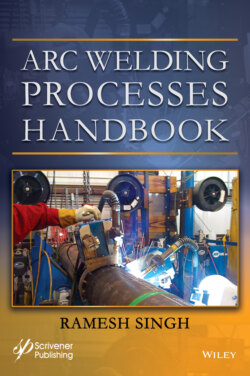Читать книгу Arc Welding Processes Handbook - Ramesh Kumar Singh - Страница 19
1.4 Defining Welding
ОглавлениеThe AWS definition for welding is “a materials joining process which produces coalescence of materials by heating them to suitable temperatures with or without the application of pressure or by the application of pressure alone and with or without the use of filler material”.
Welding is often compared in a very rudimentary way with casting. The comparison with casting involves the fact that in welding a volume of molten metal is solidified (cast) within the confines of a solid base metal (mold). The base metal may have been preheated to retard the cooling rate of the weld joint just as in casting molds are preheated to slow down cooling and reduce “Chilling” of the casting. Upon solidification, the weld deposit or casting can be directly put into service, as the welds are often used in as-welded condition or may be heat-treated or worked further on as required. However, such comparison is not an accurate depiction of welding process, nor it is a fair comparison. For example, in welding the base metal “mold” is part of the weld, unlike the mold of a casting, which is removed after solidification, so unlike casting process, what happens to the “mold” is of significant importance in welding. Unlike casting, in welding the solidification and the nucleation of weld metal takes effect on the basis of the base metal grain structure that is just adjacent to the molten metal of welding and a unique set of metallurgy is created in the base metal that is heated to above austenitic temperature range, this small band of base metal is called heat affected zone (HAZ).
Welding involves small area relative to the full size of the structure, the base material. Thus, a weld is a very small mass of metal, mostly two metals that are heated very rapidly by intense heat and cooled rapidly, this rapidly heated and cooled small area often overlap each other in succession to create yet another complex metallurgical condition. The dissipation of heat is by all three modes; Conduction, Radiation and Convection. Often the large surrounding mass of colder base metal is heated by conduction process, which is the major source of heat transfer from weld. The heating and after welding the cooling process are dynamic, equilibrium conditions are seldom seen in conventional welding operations, in fact welding conditions represent a great departure from equilibrium. That is the reason weld zones often display unusual and verity of structures and properties, all this within the confines of a very small area affected by welding process.
It is thus important that a welding personnel have a very good understanding of “Heat” in welding. The understanding of the heat generation and physics of welding are important steps in making of a good welding engineer, and it helps being a good welder as well.
Welding is carried out based on a well thought out and specific plan in order to attain the required material properties. Many regulatory and industrial specifications have well developed process to get the plan in activation. Such plans are called Welding Procedures, and a well laid out sequence of operation is established for the welding qualifications, of both the procedure’s ability to meet required metallurgical and mechanical properties and also a welder’ ability to repeatedly produce the quality of weld desired through that welding procedure. Following is a brief discussion on welding procedures and their role in welding application.
